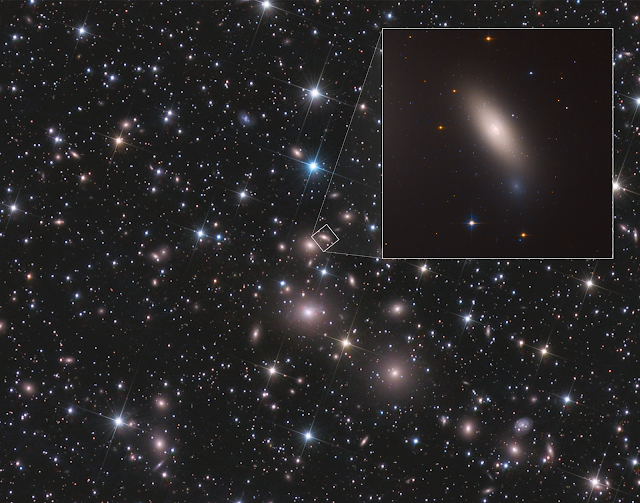New images of the ancient relic Galaxy: NGC 1277
(Image from nasa.org)
A Galaxy titled NGC 1277, at a distance of approximately 225 million light years away as measured and viewed from Earth. It is considered one of the early Galaxies, discovered within the Galaxy clusters of Pegasus, which are some of the first formed Galaxies after the big bang. A star rich lenticular Galaxy consisting of red population three stars. Billions of years old.
Lenticular galaxies are shaped circular without spiral, usually very densely packed with old red metal rich 'relic' stars, as the centre of these type of ancient Galaxy lies a super massive black hole, larger than the Milky Way's. The theory is that Lenticular galaxies didn't form as well, within the context of a cosmological observation, as opposed to spiral Galaxies that grow in mass and are less dense, with small (stella mass) black holes at their centres.
From NASA
"It's a markedly different environment for NGC 1277. The galaxy lives
near the center of the Perseus cluster of over 1,000 galaxies, located
240 million light-years away. But NGC 1277 is moving so fast through the
cluster, at 2 million miles per hour, that it cannot merge with other
galaxies to collect stars or pull in gas to fuel star formation. In
addition, near the galaxy cluster center, intergalactic gas is so hot it
cannot cool to condense and form stars.
The team started looking for "arrested development" galaxies in the
Sloan Digital Sky Survey and found 50 candidate massive compact
galaxies. Using a similar technique, but out of a different sample, NGC
1277 was identified as unique in that it has a central black hole that
is much more massive than it should be for a galaxy of that size. This
reinforces the scenario that the supermassive black hole and dense hub
of the galaxy grew simultaneously, but the galaxy's stellar population
stopped growing and expanding because it was starved of outside
material.
"I didn't believe the ancient galaxy hypothesis initially, but
finally I was surprised because it's not that common to find what you
predict in astronomy," Beasley added. "Typically, the universe always
comes up with more surprises that you can think about."
A red and dead relic?
Or, could it have been the stella remains of a technologically advanced intelligent life form that evolved so far into its intelligence, they've now reached pure transcendence. Exhausting the energy of their stars, expanded the Galaxy's black hole. Thus manipulating the very essence of a Galaxy's dynamics. Reshaping it. And now they reside within another dimension of reality.



Comments
Post a Comment